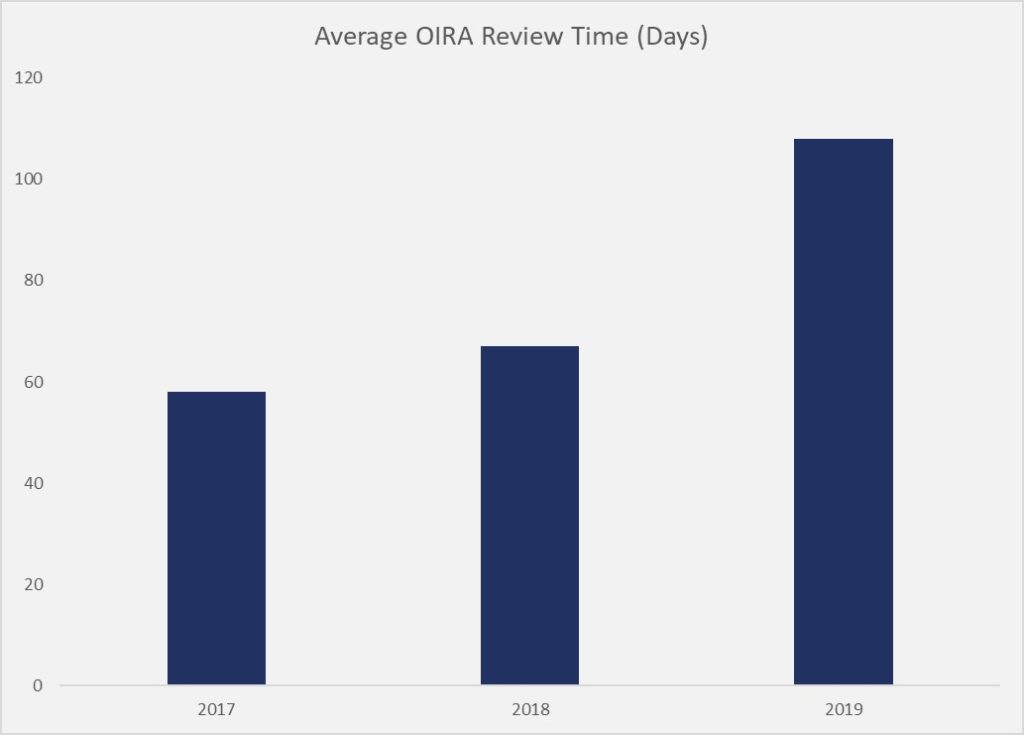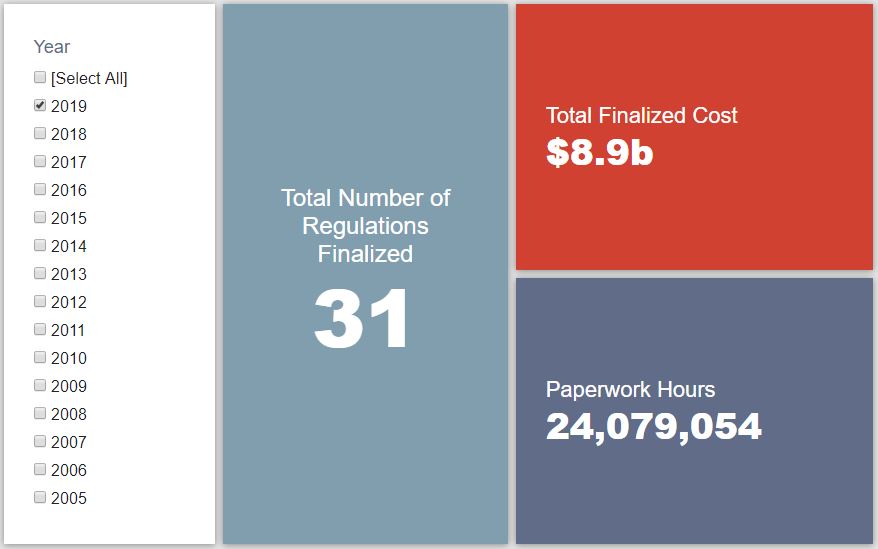Week in Regulation
February 25, 2019
A Mildly Regulatory Week
Roughly following the trend from the previous week, published net costs went up nominally while paperwork burdens went down. No individual rulemaking in last week’s editions of the Federal Register had a cost or savings estimate in excess of $40 million. Between both proposed and final rules last week, agencies published $52.8 million in total net costs, but also put forward 347,005 hours of paperwork reductions.
REGULATORY TOPLINES
- New Proposed Rules: 31
- New Final Rules: 50
- 2019 Total Pages: 5,931
- 2019 Final Rule Costs: $8.9 Billion
- 2019 Proposed Rule Costs: $2.9 Billion
TRACKING THE REGULATORY BUDGET
The most notable deregulatory action of the week was a proposed rule from the Drug Enforcement Administration (DEA). The proposal would “implement a new single-sheet format for order forms (DEA Form 222) which are issued by DEA to DEA registrants to allow them to order schedule I and/or II controlled substances.” DEA estimates that this change would bring annual savings of $25.9 million and reduce the paperwork burden imposed by Form 222 from its current 1,453,348 hours to 1,030,000 hours. Since it is still a proposed rule, these savings do not yet factor into fiscal year (FY) 2019’s regulatory budget under Executive Order (EO) 13,771.
The most significant final rule that contributed savings to FY 2019’s regulatory budget comes from the Environmental Protection Agency (EPA). The rule makes certain adjustments to how EPA handles pharmaceutical waste. These changes – some regulatory, some deregulatory – yield net savings of nearly $15 million per year. EPA currently has six EO 13,771 deregulatory actions with some quantified economic estimate against two such regulatory actions (a 3:1 ratio), but is still far from its FY 2019 goal of $817.8 million in net savings.
So far in FY 2019 (which began on October 1, 2018), there have been 31 deregulatory actions (per the rubric created by EO 13,771 and the administration’s subsequent guidance document) against 11 rules that increase costs and fall under the EO’s reach. Combined, these actions yield quantified net costs of roughly $10.2 billion. This total, however, includes the caveat regarding the baseline in the Department of Agriculture’s “National Bioengineered Food Disclosure Standard.” If one considers that rule to actually be deregulatory, the administration-wide net total is approximately $3.5 billion in net costs. The administration’s cumulative savings goal for FY 2019 is approximately $18 billion.
THIS WEEK’S REGULATORY PICTURE
One can describe “regulatory policy” in many ways: mundane, opaque, monotonous, complex, legalistic. The list goes on. In order to help provide a clearer and more straight-forward view into this world, the American Action Forum will seek to provide a brief illustration of a notable regulatory trend we have identified in a given week. This week’s entry: a comparison of the average review time for rules at the Office of Information and Regulatory Affairs (OIRA) to this point in 2019 versus the previous two years.
The average review time is up significantly so far in 2019. One would suspect the government shutdown, which severely curtailed OIRA’s staffing and regulatory review capabilities, as the primary culprit. But a closer look at the data shows that a combination of two other factors mainly drive the higher average. The first is the limited number of reviews completed at this point in 2019 (31). The second is that five of these reviews lasted longer than 200 days – meaning they were submitted from July 2018 and earlier – presumably because they were among the more complex rules developed by the Trump Administration over its first two years. As 2019 continues, we should expect the average review time to drop as the administration submits more typical rules for OIRA review. If 2019’s average review time remains higher than the previous two years, however, the likeliest reason is that the submitted rules are more complex to analyze or involve more interagency review.
TOTAL BURDENS
Since January 1, the federal government has published $11.8 billion in net costs (with $8.9 billion in finalized costs) and 18.4 million hours of net paperwork burden increases (including roughly 24.1 million hours from final rules). Click here for the latest Reg Rodeo findings.













